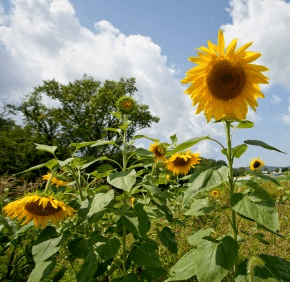By Maria Wiering
mwiering@CatholicReview.org
A school garden, blue bird houses and recycling containers are evidence of St. John Regional Catholic School’s efforts to integrate environmental stewardship into its curriculum and school community.
The Frederick preschool-to-eighth-grade school was named a Maryland Green School in April, and is among 15 Catholic schools in the Archdiocese of Baltimore to receive the recognition since the program began in 1999.
“It’s something a lot of schools are pursuing as we reduce our impact on the environment, but ultimately, these practices save money as well,” said Paul Fer, the school’s assistant principal. “Overall, it’s a responsible action by any institution, especially a school.”
The Maryland Association for Environmental and Outdoor Education (MAEOE) established the Maryland Green Schools Program to foster student-led, environmentally sustainable practices that are integrated into a school’s curriculum and community life, said Laura Johnson Collard, its executive director.
“Children are the future,” she said, “and if we can teach them an understanding and awareness of their impact on Maryland’s natural resources, and things they can do in school that can transfer to home, that’s a very positive way to respond.”
To earn certification, schools must demonstrate at least two years of curriculum integration, school-wide environmental behavior changes, professional development for staff members and school-wide celebration of green practices, as well as student-driven initiatives and community partnerships.
The program has motivated St. John Regional to move to paperless communications, implement energy-saving systems and develop a swale, a landscape designed to manage storm water runoff.
In its application, St. John Regional highlighted the work of Cecilia Bracey, who in eighth grade taught a rain barrel-making workshop at the school, leading to her Girl Scout Silver Award. Now a rising sophomore at St. John’s Catholic Prep in Buckeystown, Bracey hopes to return to the school for her Gold Award project to work on the school’s swale, which is planted with native grasses.
“I think it’s important to preserve our planet,” said Bracey, a parishioner of St. John the Evangelist. “I’m really into science, and I think that nature is one of the prettiest and most awesome forces in our universe.”
Mother Seton School in Emmitsburg, first certified as a Green School in 2009 and recertified this year, integrates sustainable topics into every subject, including language arts.
“We’re doing a really good job of working environmental topics into what we’re teaching,” said Danielle Kuykendall, the middle school science teacher.
The prekindergarten-to-eighth-grade school composts food scraps, uses green cleaning products and maintains a butterfly garden to attract migrating Monarchs.
“We want people to understand that because we’re a Catholic school, we think it’s really important that part of our curriculum – what we’re doing every day – is helping these kids understand that we need to take care of God’s earth,” Kuykendall said.
By the numbers
In 2014, the Maryland Association for Environmental and Outdoor Education newly certified 45 schools, including St. John Regional Catholic School in Frederick and Trinity School in Ellicott City. Of Maryland’s more than 2,200 schools, 469 are Green Schools certified.
Of the 20 Catholic high schools in the archdiocese, three are Green Schools, as are 12 of the 50 Catholic elementary and middle schools. St. Casimir in Canton was the first Catholic school in the archdiocese to receive the certification.
Also see:


